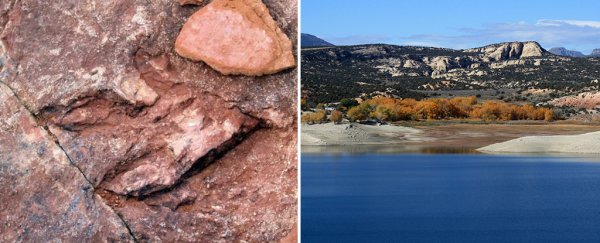Tourists visiting Red Fleet State Park in Utah have heavily damaged a site lined with hundreds of priceless prehistoric raptor tracks.
Park officials say that visitors have been dislodging the dinosaur tracks, which are imprinted in sandstone, and then throwing the pieces into a nearby lake.
Utah Division of State Parks spokesperson Devan Chavez said by his conservative estimate at least 10 of the larger footprints have vanished in the past six months. These ranged from 8 to 43 centimetres (3 to 17 inches) in size.
But don't go cursing humanity or tourism just yet.
It's likely that these people have no idea what they're doing. Because while some of the imprints are easily visible, others are more difficult to make out.
"It's become quite a big problem," Chavez told The Associated Press (AP).
"They're just looking to throw rocks off the side. What they don't realize is these rocks they're picking up, they're covered in dinosaur tracks."
The three-toed tracks most likely belong to a prehistoric raptor called dilophosaurus - the same species that made a terrifying cameo in the original Jurassic Park.

Dilophosaurus are some of the largest carnivorous dinosaurs of the Early Jurassic Period, which was about 193 million years ago. Way back then, the dry and dusty site where these tracks are located was more like a muddy and mossy bog.
The footprints have led palaeontologists to theorise that these raptors used to ambush other dinosaurs while they were resting or drinking from the swamp.
Now, park officials are doing everything they can to protect the precious imprints, which provide invaluable information about Utah in the Early Jurassic Period.
The Red Fleet State Park manager Josh Hansen told The Salt Lake Tribune about a recent occasion where he caught a young kid throwing whole slabs of the stone into the lake. He said he saw two toe imprints on one slab, saving it in the nick of time.
"I saved that one," Hansen said. "He had already thrown multiple."
While some of the imprints can be rescued by a diving team, others are too smashed up or dissolved to be salvaged.
"Some of them are likely lost forever," Chavez said.
The park is now putting up more signs and specifically asking tourists not to touch the sandstone.
Even still, though, people aren't getting the message.
"You'd think common sense would provide guidance, but it's not coming across in people's mind," said Hansen, adding that in the past two weeks he has responded to two more cases.
Although it is true that the tracks are not considered fossils by palaeontologist standards, they are legally considered fossils under Utah code.
This means that anyone who destroys them could be charged with a felony. Obviously, this is not what the park rangers want, but if people don't start observing the signs and obeying the rules, there might not be another solution.
Park officials say from now on they will be "cracking down" on the problem a lot more.
